Sphinx franckii
|
|
Updated as per James P. Tuttle's The Hawk Moths of North America, July 26, 2012
Updated as per personal communication with Don Davison (Bullitt County, Kentucky, East of Shepherdsville; guara); July 26, 2012
Updated as per personal communication with Brent Steury (Turkey Run Farm, McLean, Fairfax County, Virginia July 1, 2014); July 1, 2014
Updated as per personal communication with Joe Garris (Stillwater, Sussex County, New Jersey, July 9, 2019; July 11, 2020); July 14, 2020; August 1, 8, 13, 23, 31, 2020
|
Sphinx franckii
Franck's Sphinx Moth
Neumoegen, 1893
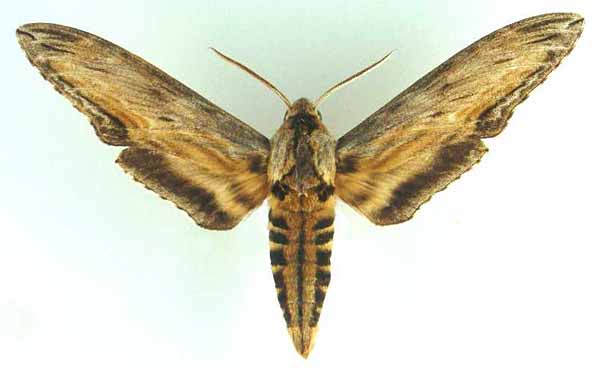
Sphinx franckii male courtesy of Vernon A. Brou.
This site has been created by Bill Oehlke.
Comments, suggestions and/or additional information are welcomed by Bill.
TAXONOMY:
Family: Sphingidae, Latreille, 1802
Subfamily: Sphinginae, Latreille, 1802
Tribe: Sphingini, Latreille, 1802
Genus: Sphinx Linnaeus, 1758 ...........
Species: franckii Neumoegen, 1893
|
DISTRIBUTION:
Franck's Sphinx Moth, Sphinx franckii
(Wingspan: 100--128mm), flies in lowland deciduous woodland in the eastern USA, ranging from New York State to
northern Florida, and eastwards to Missouri and Louisiana.
The specimen type locality
is Kansas City, Missouri, USA.
Information and larval image on this page is courtesy of Tony Pittaway.
Joe Garris reports taking a female franckii at mercury vapour light
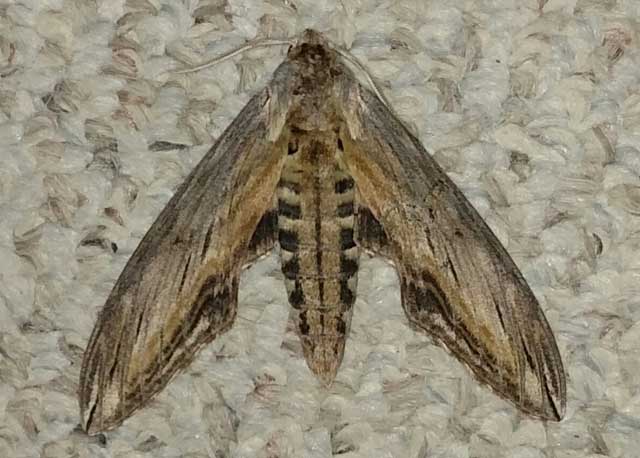
Sphinx franckii, Stillwater, Sussex County, New Jersey,
July 9, 2019, courtesy of Joe Garris.
The outer margins of the forewings are slightly concave in the male, but not in the female. The costal half of the
forewings are grey, but the posterior portion is a distinctive warm yellowish-brown; the boundary between these two
areas is marked with a series of dark diagonal streaks. The hindwings are black with a brown basal patch, a median
band and margin.
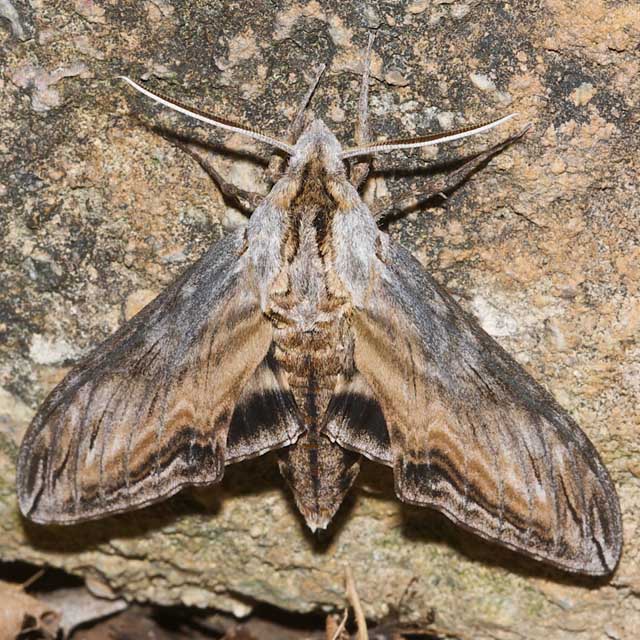
Sphinx franckii, Woodbury, Cannon County, Tennessee,
June 8, 2010, courtesy of Carol Wolf.
FLIGHT TIMES:
Sphinx franckii adults are univoltine in the north, with adults mainly in late
June and early July. Farther south there may be a partial second brood in August-September.
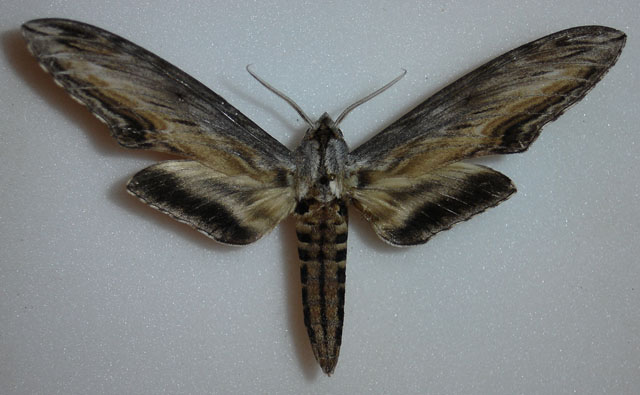
Sphinx franckii, Center, Metcalfe County, Kentucky,
August 2, 2010, 37'07N 82'23W, courtesy of Derek Bridgehouse.
ECLOSION:
Pupae probably wiggle to surface from subterranean chambers just prior to eclosion.
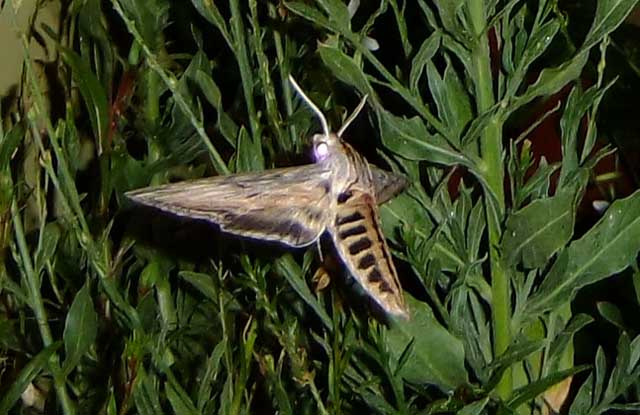
Sphinx franckii, Bullitt County, Kentucky,
seeking nectar at guara, July 25, 2012, courtesy of Dan Davison.
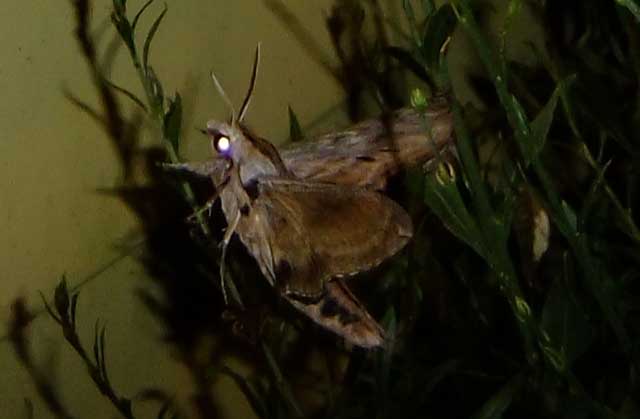
Sphinx franckii, Bullitt County, Kentucky,
seeking nectar at guara, July 25, 2012, courtesy of Dan Davison.
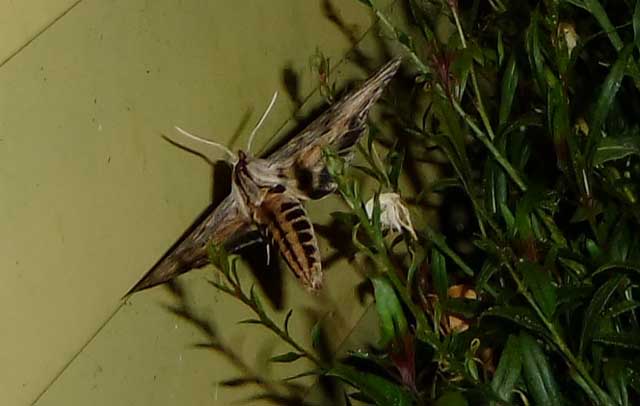
Sphinx franckii, Bullitt County, Kentucky,
seeking nectar at guara, July 25, 2012, courtesy of Dan Davison.
SCENTING AND MATING:
Females call in the males with a pheromone released from a gland at the tip of the
abdomen. Adults nectar at a variety of flowers. Moths come in to lights.
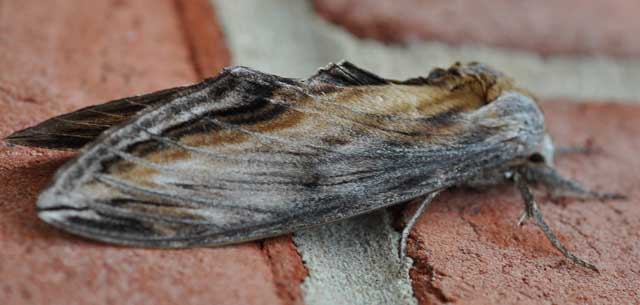
Sphinx franckii, Turkey Run Park, McLean, Fairfax County, Virginia,
July 1, 2014, courtesy of Brent Steury.
EGGS, LARVAE, PUPAE:
The ovoid egg is a glossy pale yellow, 1.90 x 1.70mm, with the young larva
becoming visible through the shell. Eggs are deposited singly and the newly emerged larva eat at least half the egg shell.
On hatching, the pale yellow larva measures approximately 5-6mm and bears
a large, black-tipped, orange-red horn. With feeding the basic body coloration becomes greenish and later in the instar
a pale, double, dorso-lateral line appears, stretching from the horn to the head. There is also a subspiracular line of the
same colour on the anterior segments. During this stage it rests stretched out along the midrib on the underside of a
leaf and eats very little.
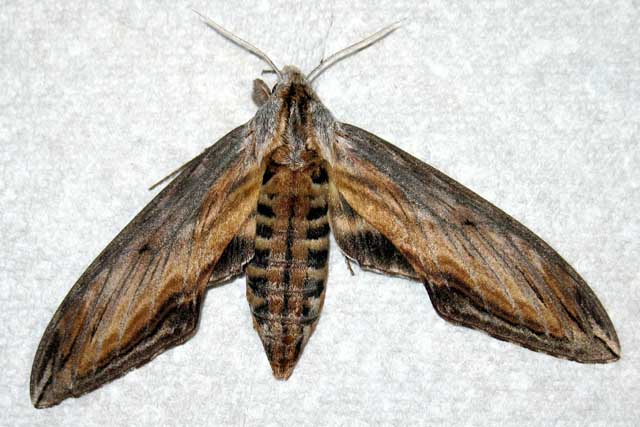
Sphinx franckii female, Stillwater, Sussex County, New Jersey,
July 11, 2020, courtesy of Joe Garris.
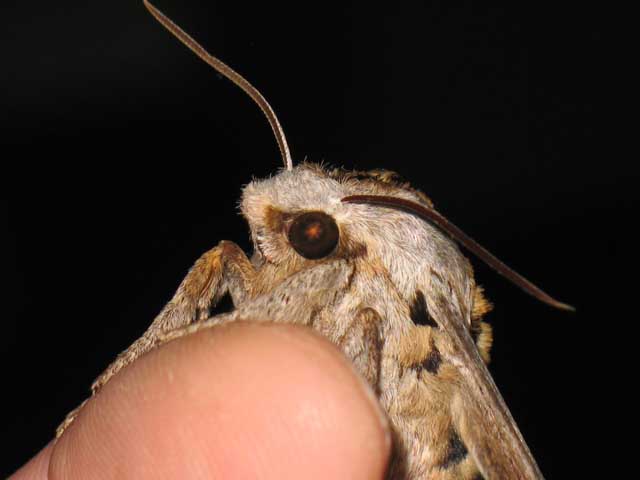
Sphinx franckii female, Stillwater, Sussex County, New Jersey,
July 11, 2020, courtesy of Joe Garris.
Joe Garris sends the following images of a first instar larva, probably 3-4 days out of the egg, deposited by the female depicted in the images directly above.
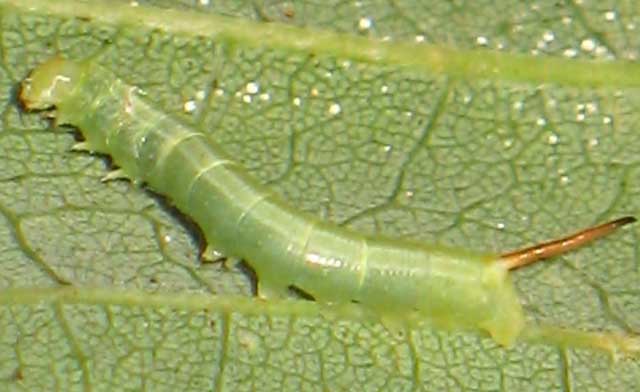
Sphinx franckii first instar, probably 3-4 days old, Stillwater, Sussex County, New Jersey,
July 24-25, 2020, courtesy of Joe Garris.
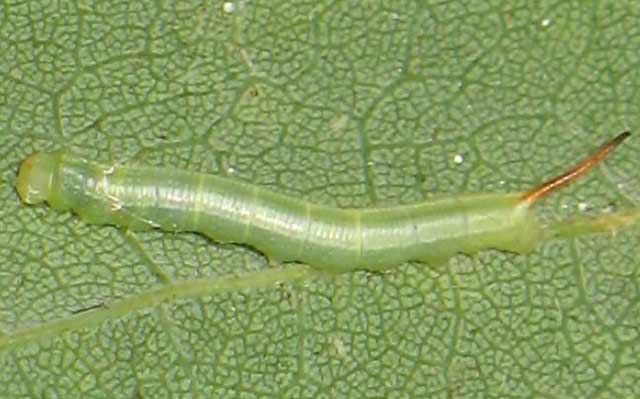
Sphinx franckii first instar, probably 3-4 days old, Stillwater, Sussex County, New Jersey,
July 24-25, 2020, courtesy of Joe Garris.
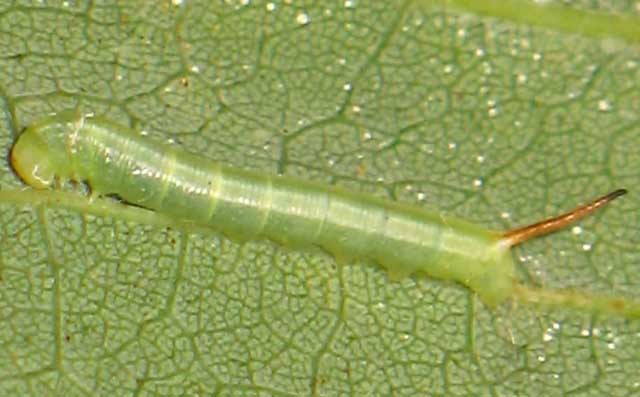
Sphinx franckii first instar, probably 3-4 days old, Stillwater, Sussex County, New Jersey,
July 24-25, 2020, courtesy of Joe Garris.
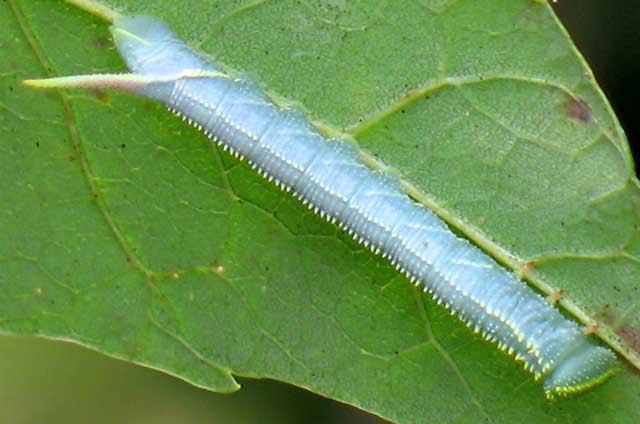
Sphinx franckii second or third instar, probably 9 days old, Stillwater, Sussex County, New Jersey,
August 1, 2020, courtesy of Joe Garris.
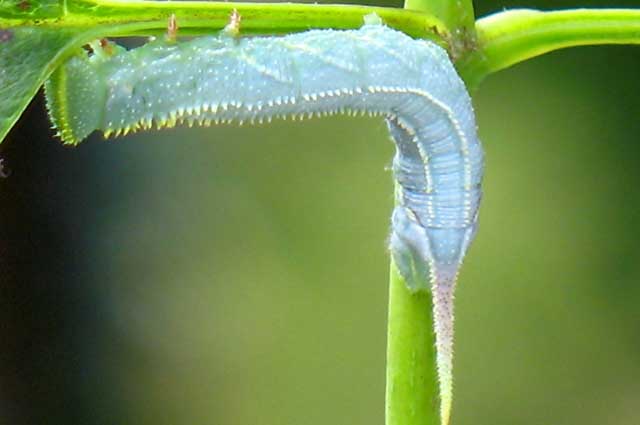
Sphinx franckii second or third instar, probably 9 days old, Stillwater, Sussex County, New Jersey,
August 1, 2020, courtesy of Joe Garris.
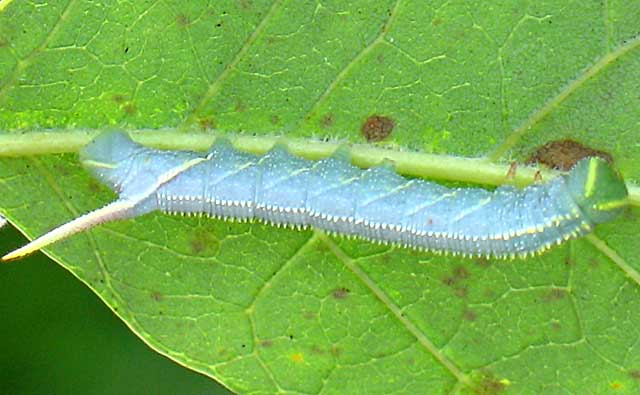
Sphinx franckii second or third instar, probably 9 days old, Stillwater, Sussex County, New Jersey,
August 1, 2020, courtesy of Joe Garris.
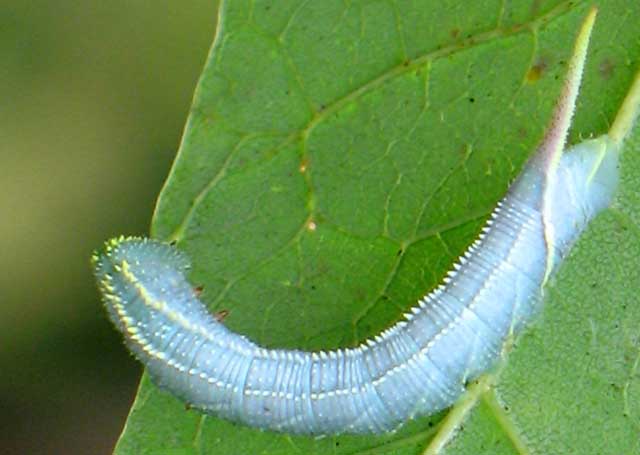
Sphinx franckii second or third instar, probably 9 days old, Stillwater, Sussex County, New Jersey,
August 1, 2020, courtesy of Joe Garris.
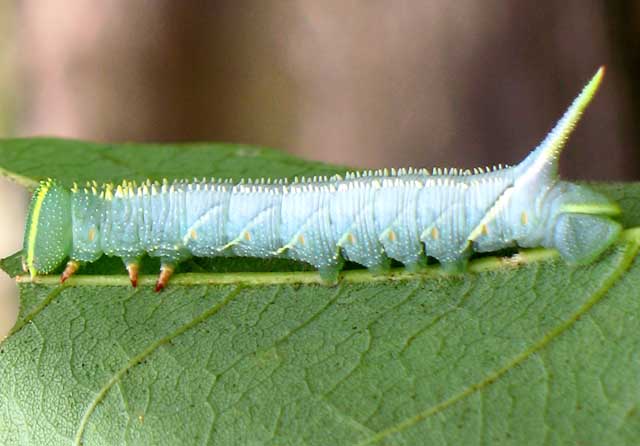
Sphinx franckii second or third instar, probably 16 days old, Stillwater, Sussex County, New Jersey,
August 8, 2020, courtesy of Joe Garris.
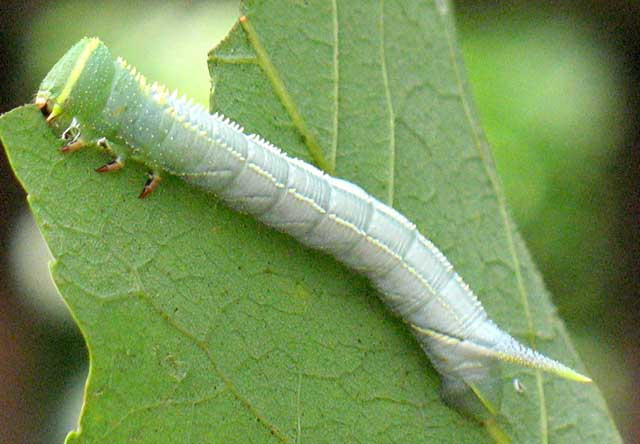
Sphinx franckii second or third instar, probably 16 days old, Stillwater, Sussex County, New Jersey,
August 8, 2020, courtesy of Joe Garris.
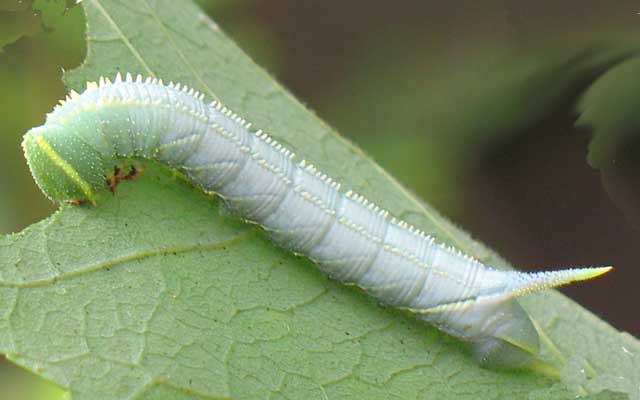
Sphinx franckii second or third instar, probably 16 days old, Stillwater, Sussex County, New Jersey,
August 8, 2020, courtesy of Joe Garris.
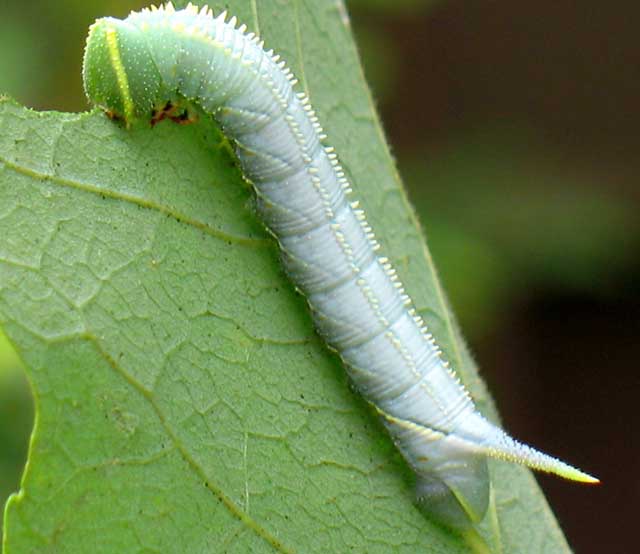
Sphinx franckii second or third instar, probably 16 days old, Stillwater, Sussex County, New Jersey,
August 8, 2020, courtesy of Joe Garris.
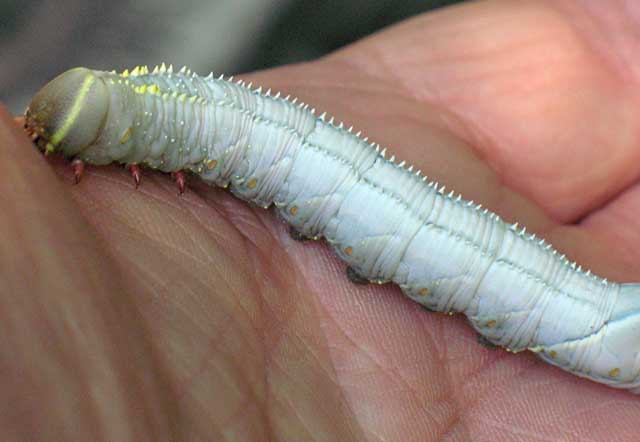
Sphinx franckii third, fourth or fifth instar, probably 21 days old, Stillwater, Sussex County, New Jersey,
August 13, 2020, courtesy of Joe Garris.
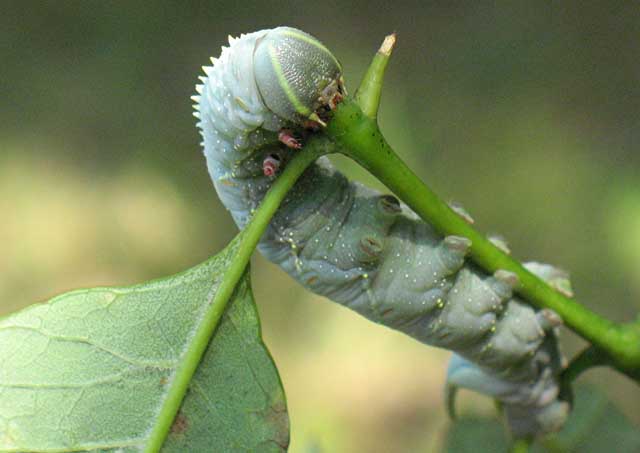
Sphinx franckii third, fourth or fifth instar, probably 21 days old, Stillwater, Sussex County, New Jersey,
August 13, 2020, courtesy of Joe Garris.
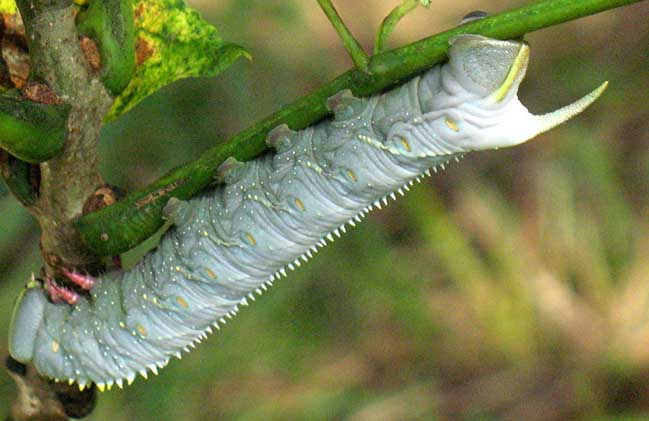
Sphinx franckii third, fourth or fifth instar, probably 21 days old, Stillwater, Sussex County, New Jersey,
August 13, 2020, courtesy of Joe Garris.
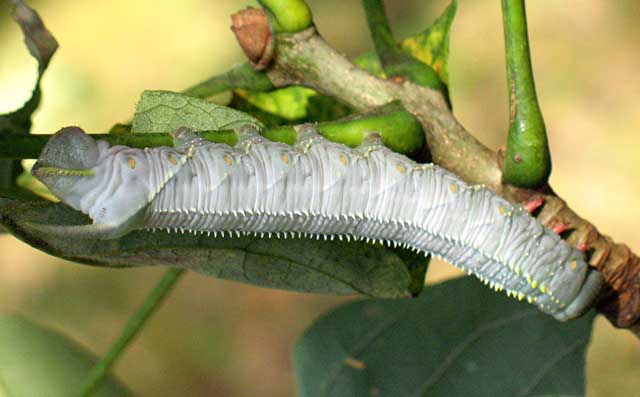
Sphinx franckii third, fourth or fifth instar, probably 21 days old, Stillwater, Sussex County, New Jersey,
August 13, 2020, courtesy of Joe Garris.
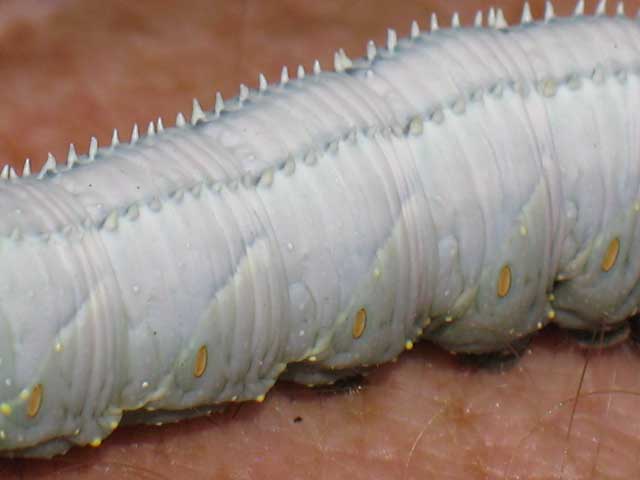
Sphinx franckii third, fourth or fifth instar, probably 21 days old, Stillwater, Sussex County, New Jersey,
August 13, 2020, courtesy of Joe Garris.
Joe writes, August 15, "The franckii caterpillars are huge now. Most are about 4" and can easily stretch to well over 5" long. I'm sure it's not going to be much
longer. I'm checking them every 2 days and moving them to new ash foliage. They are devouring the foliage in the sleeves almost completely in that time. I have
two to a sleeve in most but 3 to a sleeve in a couple."
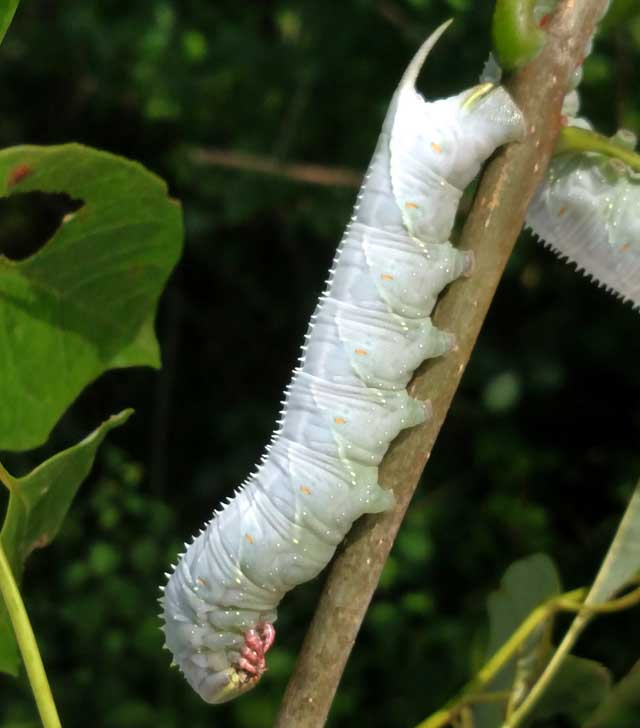
Sphinx franckii final instar, Stillwater, Sussex County, New Jersey,
August 15, 2020, courtesy of Joe Garris.
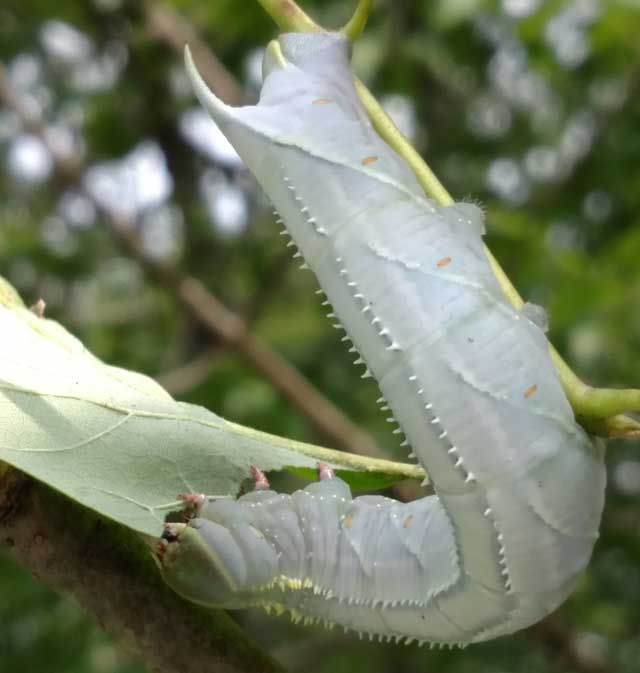
Sphinx franckii final instar, Stillwater, Sussex County, New Jersey,
August 15, 2020, courtesy of Joe Garris.
Joe writes, August 23, 2020, "Nine of the franckii caterpillars have gone prepupal over the last couple of days (starting August 20). That's about half of the franckii caterpillars
I had sleeved. All have survived. I've attached a photo of one of the prepupal caterpillars. They are a lighter pale blue when they are going prepupal and one
of my observations is that the yellow stripes on their faces seems faded. They're really big. At first the caterpillars that were on the verge of prepupal
would stop eating and hang like an upside down question mark. Within a day they would either be at mouth of the sleeve where it was tied on the branch or
they would be in the bottom of the sleeve."
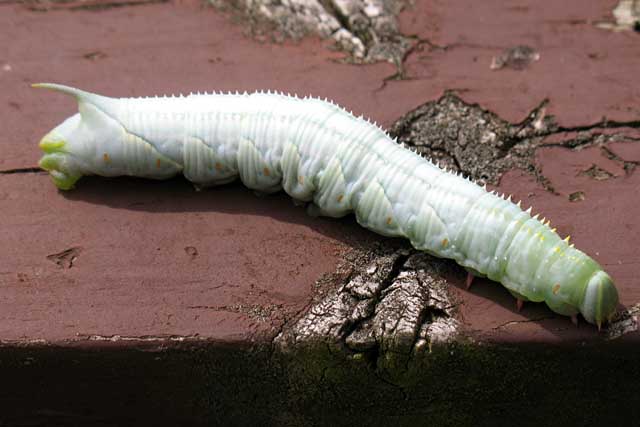
Sphinx franckii prepupal, Stillwater, Sussex County, New Jersey,
August 20, 2020, courtesy of Joe Garris.
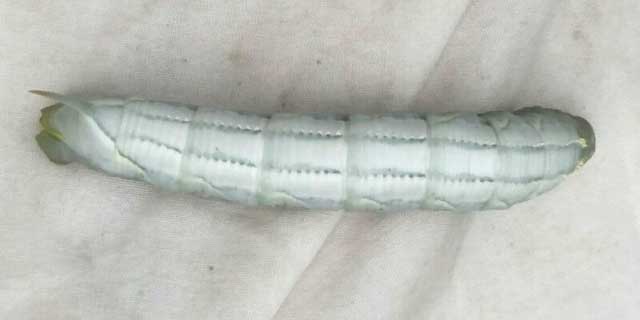
Sphinx franckii prepupal, Stillwater, Sussex County, New Jersey,
August 20, 2020, courtesy of Joe Garris.
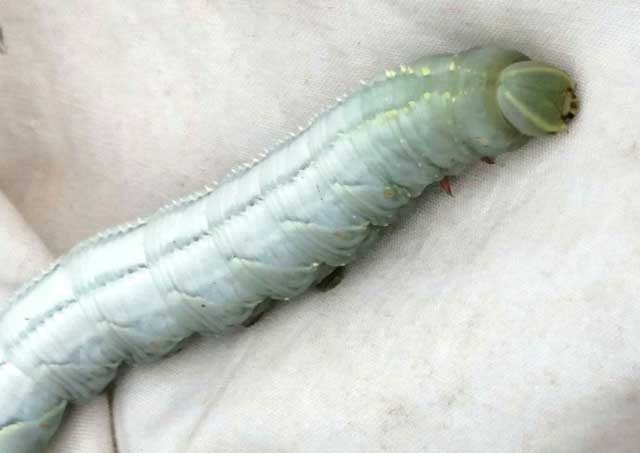
Sphinx franckii prepupal, Stillwater, Sussex County, New Jersey,
August 20, 2020, courtesy of Joe Garris.
Joe adds, "Just peeked at the containers of caterpillars that were prepupal on 8/20. Here's a quick picture."
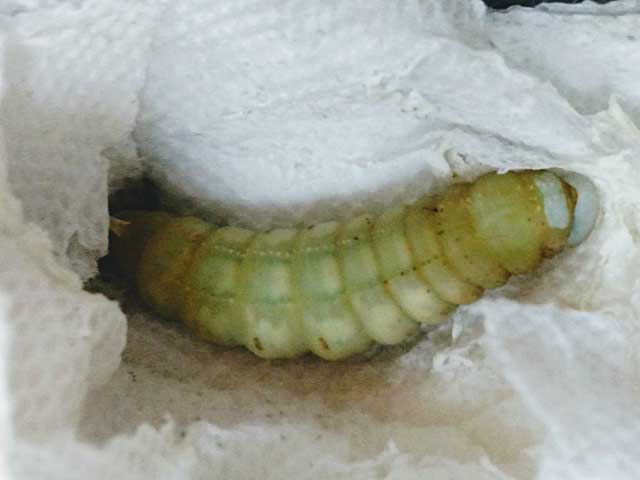
Sphinx franckii three days into pupation preparation, Stillwater, Sussex County, New Jersey,
August 23, 2020, courtesy of Joe Garris.
Larvae feed exclusively on various species of ash (Fraxinus). Reports of this species on elm (Ulmus) are
erroneous and are probably due to confusion with Ceratomia amyntor (Geyer, [1835]).
After the first moult the body becomes glaucous green and very shagreened. The dorsal surface is paler, almost white.
The upper of the double, dorso-lateral lines becomes dominant and very white, with seven oblique white stripes
developing laterally. A ventro-lateral line of the same colour appears on the thoracic segments. The head is pale green,
triangular, notched and spiny at the vertex, with yellow cheek stripes, and the horn is orange with paler, almost yellow,
edging. In behaviour it continues to be very lethargic.
In the third instar the basic body colour becomes bluish-grey, tending to whitish dorsally. The oblique lateral stripes
become creamy, that at the base of the horn being more prominent. The head is apple-green with yellow cheek stripes,
the horn pale buff-yellow with a tint of orange dorsally. The latter also bears fine, purple tubercles. The upper of the pair
of dorso-lateral lines is now very prominent, creamy-white, and bears closely-packed, tooth-like tubercles in the form of
a ridge. The true legs are green with pink tips.
The fourth instar is very similar to the third, but with clear sea-green shading/edging down the front of each oblige
lateral stripe. The horn is robust, straight, pale cream laterally, bluish-grey above and below, and blends with the
prominent last oblique lateral stripe. In fact, all lateral stripes bar the last stripe become very faint, with the lower half of
each being more yellow than white, and often consisting of no more than a row of large tubercles. The 'teeth' on the
upper dorso-lateral line are now separated, giving the impression of a pair of parallel toothed crest down the larval
back, with those towards the head being yellower and larger. The head and thoracic segments are flushed with
apple-green, with the heavily armoured anal flap being edged with yellow. The larva now likes to hang from the
petiole beneath a leaf. Strangely, after a few days of feeding the larva will often sever most of the upper leaf by
chewing through the petiole.
The final instar is very much like the fourth. The sea-green head is now broadly triangular with pale yellow cheek
stripes. The thoracic segments are compressed laterally and the spiracles are orange. The very stout horn is
slightly curved, blue-grey above, greyish below, and creamy laterally. Dorsally, the abdominal segments are
almost totally white apart from sea-green lines bordering the toothed crests and, occasionally, a lilac blush.
The basel segment of each true leg is green with a yellow top, the central segment is red and the tip pinkish.
Sphinx franckii larva on Fraxinus, December 24, 2008, Arkansas County, Arkansas, courtesy of Tony Pittaway. |
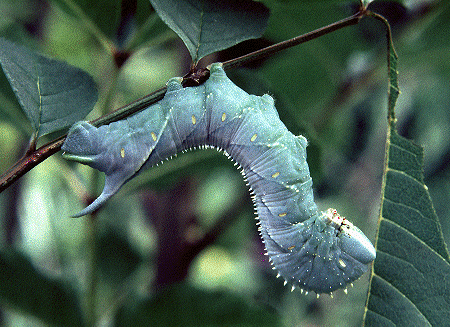 |
Mature larvae are full-fed at 85--92mm.
The pupa is 50--56mm long and a dark blackish-brown, but the intersegmental cuticle of mobile segments is a dark
mahogany-brown. The tongue-case is very short (5mm), free, but lying flat along the ventral surface.
The cremaster is robust and cylindrical with a single terminal spine.
When most Sphingidae larvae pupate, the fresh pupal shell is often a translucent greenish yellow and is very soft (best not to handle). In a day or so, possibly
overnight, the shell darkens and hardens significantly. The shed larval skin is visible in the image directly below.
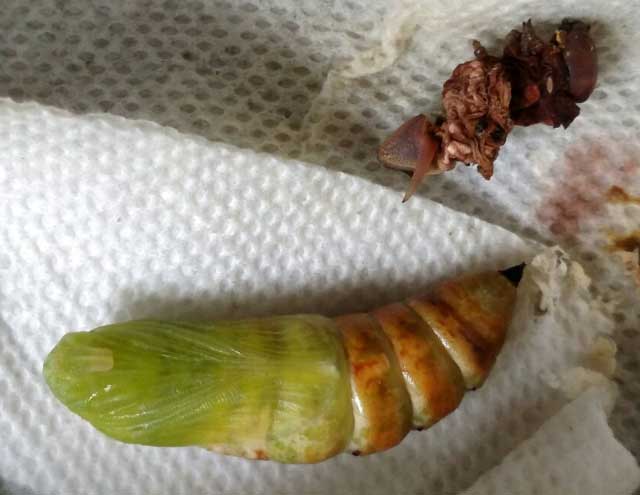
Sphinx franckii fresh pupa, Stillwater, Sussex County, New Jersey,
August 24, 2020, courtesy of Joe Garris.
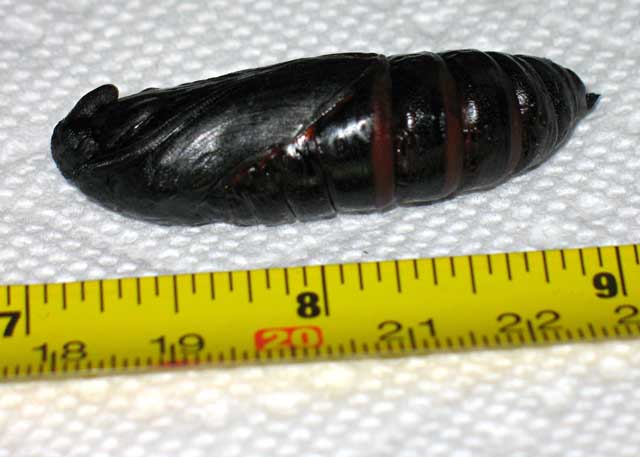
Sphinx franckii hardened pupa, Stillwater, Sussex County, New Jersey,
August 26, 2020, courtesy of Joe Garris.
Return to Sphingidae Index
Return to Sphingini Tribe


































